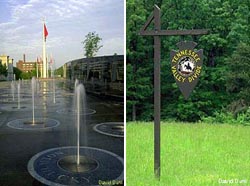
Manager, Environmental Affairs
Saturn Corporation
What Are Watersheds?
The watershed concept is easy to understand if we just remember that water flows downhill. A watershed may be as big as all the rivers emptying into the Mississippi River or as small as the rain coming off the hillside to fill a favorite fishing pond. Think of it this way:
A drop of rain falls. The drop runs off your roof, into your yard and joins other drops. They flow into a creek, then into a larger stream and finally into a river. People call the land area that collects all of these raindrops a watershed. In a more technical sense, a watershed is the landscape unit that drains into a lake, river or other waterbody. It includes the soil, air and water within that unit.
All water, sediment and nutrients flow downhill to the lowest point in a watershed. Water soaks into soil and flows underground to the lowest point the rocks will allow. This subterranean water is called ground water. Some water is not absorbed by the soil, and we call this surface water. Surface water can take on many forms including rivers, streams, wetlands and lakes. In many parts of the state, surface water and ground water interact.
WATERSHEDS HAVE CERTAIN CHARACTERISTICS.
Just like the people who inhabit them, watersheds are unique because they have individual characteristics:
SIZE. Watersheds occur in all different shapes and sizes. The US Geological Service (USGS) uses the term "Hydrologic Unit." Hydrologic Units generally follow the watershed boundaries around our major rivers but, sometimes, they don’t exactly match. In Tennessee, these hydrologic units range from 2,049 square miles (TN River, SW) down to 20 square miles (TN River, through Kentucky).
BOUNDARY. Watersheds are defined by ridges. If you could stand in a river and watch the rain strike the exact top of the ridge, you would notice that the raindrop either flowed downhill into your watershed or over the ridge into an adjacent one. In Tennessee, the ridges defining watersheds are much more obvious in East and Middle Tennessee than in West Tennessee, which is predominantly flat.
LANDSCAPE. The steepness, or slope, and cover characteristics (a discription of the vegetative and nonvegetative characteristics) of the land in a watershed determines how fast water drains and how prone it is to flooding and soil erosion. In West Tennessee, some watersheds are prone to flooding because the land is so flat that water covers adjacent fields when rivers top their banks. In East Tennessee, some watersheds are prone to flooding because the land is so steep that rainwater flows to the river faster than it can be carried on to the flood zone.
SOIL. Some soils can absorb rainwater faster than others. In West Tennessee, where the soils have a high sand content, the ground quickly soaks up rainwater. In the ridges and valleys of East Tennessee, where the soils have a higher clay content and limestone is exposed, rainwater quickly rolls off the landscape.
SOME WATERSHEDS ARE CONNECTED.
A drop of water falling on a farm in Wayne County hits a tin roof. It slowly travels over the farm and eventually may make its way into the Green River, placing it in the Green River watershed. From there, the Green River carries it to the Buffalo River, so it’s in that watershed as well. The Buffalo River flows into the Duck River, so that makes it part of the greater Duck River watershed. Since the Duck River flows into the Tennessee River, it’s now in the greater Tennessee River watershed. The Tennessee River flows into the Ohio River which flows into the Mississippi River, so it’s in those greater watersheds as well. The Mississippi River empties into the Gulf of Mexico, so it’s in that watershed, too. It’s interesting that the same drop of water falling on the roof can be in all of these watersheds at the same time. It just depends how you choose to look at it.
Clearly, this can be confusing. Usually watersheds are defined as local units; the larger areas are called drainages or basins. So that drop of rain in the Buffalo River watershed is also in the Duck, Tennessee, Ohio and Mississippi Rivers drainages.
RIVERS SHAPE THEIR WATERSHEDS.
The major rivers of Tennessee help to define the watersheds. Sometimes, watersheds are so large that they are divided for convenience. The Duck River watershed is divided into the Upper and Lower Duck River watersheds. For example, while the Tennessee River is divided into the Southwest Tennessee River, Northwest Tennessee River and Tennessee River (through Kentucky) watersheds.
Tennessee’s easternmost watersheds are the Watauga River and South Fork Holston River watersheds, while our state’s western border is defined by the Lower Mississippi River watershed. Watersheds cross political borders. For example, the Richland Creek watershed is shared with Alabama, while the Big South Fork watershed is shared with Kentucky.
WATERSHEDS ARE LOCAL.
No matter where you live, you have a watershed address. This address is just as important as your mailing address. Your watershed address tells you something about the water in your neighborhood. Some watersheds have plenty of clean water with many types of fish and mussels in the rivers. Other watersheds are polluted and lack aquatic life.
Watersheds are where our industries set up business, developers establish neighborhoods and our farmers produce food for the dinner table. Watersheds are also where our children play and families go boating and fishing. Healthy watersheds are attractive in siting new businesses and in keeping a local economy healthy. Nobody benefits from a polluted watershed.
When rivers are polluted, everyone is affected. Pollution from a pipe or sediment from an eroding streambank causes obvious problems for people living downstream. Actually, we all are affected–no matter where we live–by the higher costs of water treatment plants. Polluting a watershed is like trashing a neighborhood: it’s unsightly and costly.



